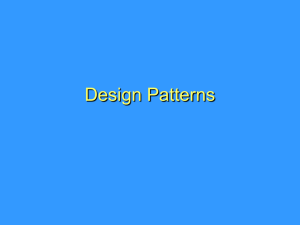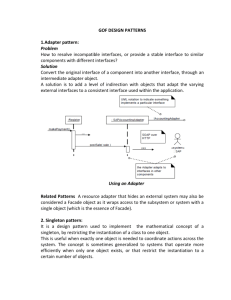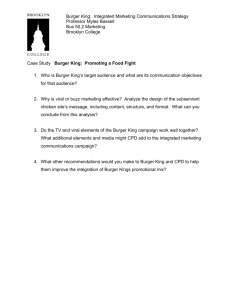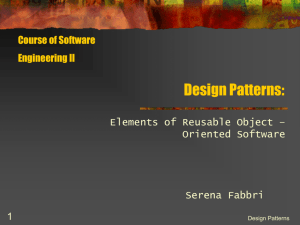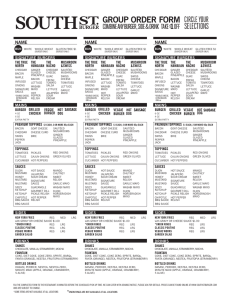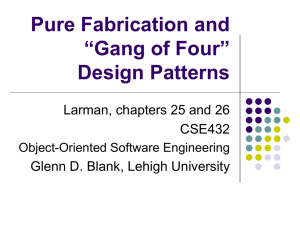Slides
advertisement
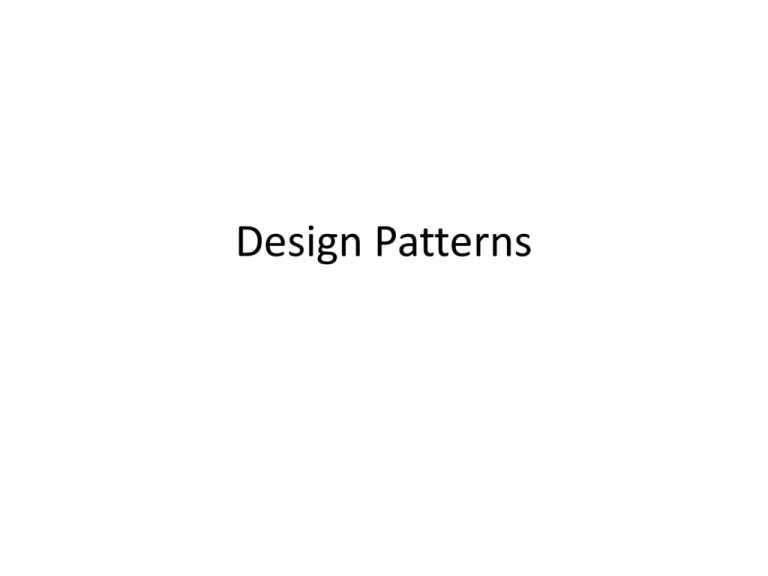
Design Patterns OO-Concepts • • • • Don’t rewrite code Encapsulation Inheritance Write flexible code Design Patterns • Time to level up! • Necessary when the projects are large • Course projects (possibly including CSE442) – – – – Small projects Requirements don’t change No design patterns needed Can get away without proper OO usage • Large projects with poor design – Do you want to refactor 10,000 lines of code? – 100,000 lines? Caution • Design patterns should be used in moderation • This is a hammer – Not all problems are nails Let’s learn these • • • • • • • • Singleton Observer pattern Decorator Pattern Factory Pattern //Command pattern Adapter Pattern State pattern MVC Singleton • There can be only one! • When your codebase needs to share a single object (not a single class) • Private constructor – What? • Controversial – Introduces global state Singleton Singleton • No need to pass the settings in every constructor and function call • Can cause issues – What if I want multiple sets of settings concurrently? – Panic – Then run multiple instances of the program and let the OS take care of it Lazy Initialization • Don’t create an object until it’s about to be used • If an object is never used, it’s never created • Can prevent multiple instantiations • Can greatly improve efficiency • At least spreads out the computation – If that’s what you’re into Observer Pattern • A single object has many other objects that need to know when it updates • On an update, broadcast to all concerned objects • But how? • Thermostat temp sensor – Furnace – AC – Mobile app Observer Pattern Observer Pattern • Loose coupling • Observers can be registered and unregistered during runtime – Flexible – Dynamic • No need to hardcode and notify every possible object that might ever be concerned • Subject is only coded once – This is a big deal! Scenario • Inspired from Head First Design Patterns • Need to compute the cost of a burger • Condiments cost extra Burger $1.50 Ketchup $0.05 Relish $0.10 Cheese $0.50 Scenario • How do we adjust to added requirement? Burger $1.50 Ketchup $0.05 Relish $0.10 Cheese $0.25 Bacon $0.50 Scenario • Customer orders double cheese and triple bacon Decorator Pattern • • • • • Wrapper classes Add features by adding wrapper classes Outer object interacts with the world Original/inner object is hidden Especially useful when original class is in a library and lacks needed funtionality Decorator Pattern Decorator Pattern Food Item cost() Condiment -Food Item cost() Burger cost() Ketchup cost() Relish cost() Cheese cost() Bacon cost() Scenario • Need to create an enemy (abstract class) • Type of enemy (concrete class) depends on: – Player’s level – Player’s location – Some randomness • Enemies are created throughout the codebase • What do you do? Factory Pattern • A class that makes objects – Don’t all classes do that? • Factory pattern – Create objects of an abstract type – No concern about the concrete class that’s instantiated Adapter Pattern • Interface between 2 different protocols • Don’t modify the source code of either • Often needed when combining code bases – Libraries • Your code uses a single interface • Adapters extend the interface and make external function calls Library we need expects this: Our code is built around this: Adapter Pattern State Pattern • CSE116 – Make a program without using “if” • CSE396 – DFA’s • Delegate functionality to a state object • Functionality changes as state chnges State Pattern State Pattern MVC • Model – Where all the action • View – What the user sees – Outputs • Controller – How the user interacts – Inputs
